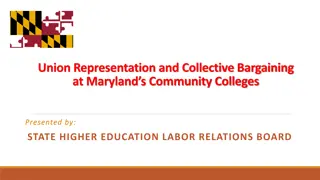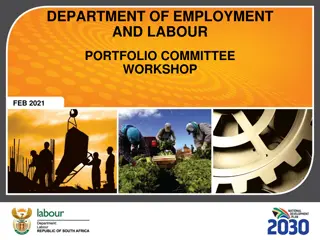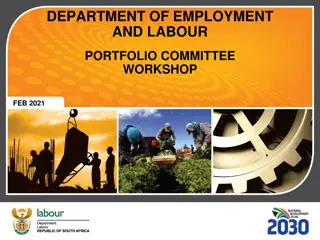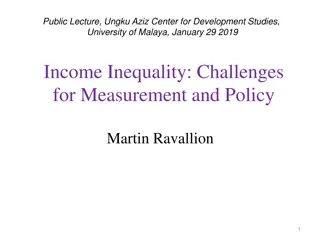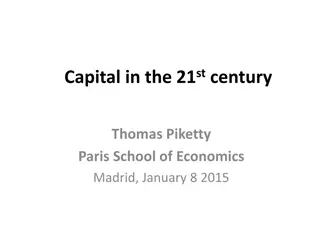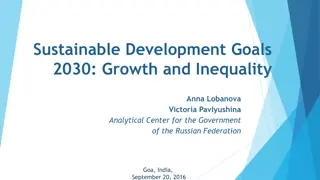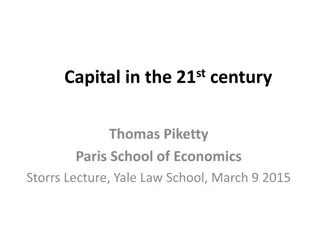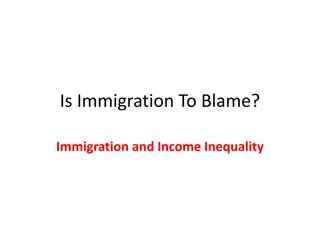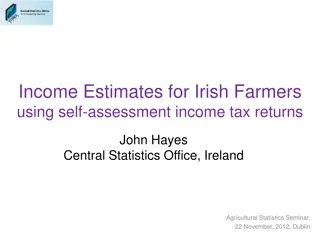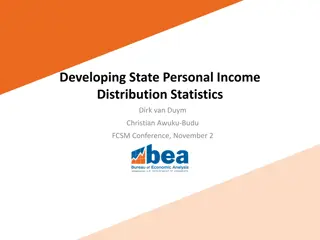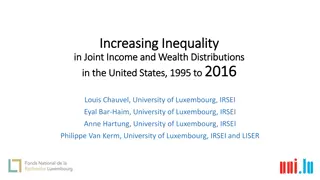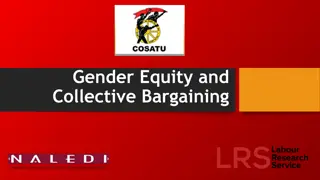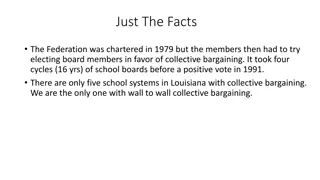Addressing Income Inequality Through Broader-Based Bargaining
A discussion on broader-based bargaining as a solution to income inequality in Ontario, despite the challenges faced in implementing it. The review highlights the importance of addressing inequality in the workforce and explores the impact of broader-based bargaining on wages, union coverage, and overall income equality.
Download Presentation

Please find below an Image/Link to download the presentation.
The content on the website is provided AS IS for your information and personal use only. It may not be sold, licensed, or shared on other websites without obtaining consent from the author.If you encounter any issues during the download, it is possible that the publisher has removed the file from their server.
You are allowed to download the files provided on this website for personal or commercial use, subject to the condition that they are used lawfully. All files are the property of their respective owners.
The content on the website is provided AS IS for your information and personal use only. It may not be sold, licensed, or shared on other websites without obtaining consent from the author.
E N D
Presentation Transcript
Broader-Based Bargaining to Address Income Inequality in Ontario An Idea Whose Time Did Not Come June 23, 2017 Law and Society Association Annual Meeting Professor Kevin Banks Centre for Law in the Contemporary Workplace Queen s University
Overview A recent, government-commissioned independent review outlined in its interim report detailed options for broader-based bargaining. These options broke with the Wagner model to some extent, yet retained enough of its key features to make them unworkable in the current industrial relations context. In the end they were not recommended by the review or adopted by the government. While the review report proposes alternative paths that could lead eventually to broader based bargaining, they are not clearly marked, and the government has yet to express support for them. This leaves state as the only agent with the potential to address the income inequality of many precarious workers.
Background - Ontarios Changing Workplaces Review Growing salience of inequality in public discourse Independent Special Advisors Focus on precarious employment Broad mandate: both employment standards and labour relations law
Broader-based bargaining and inequality Does broader-based bargaining improve wages relative to decentralized bargaining? Not necessarily. Research shows that decentralized bargaining tends to produce higher wage bargains. But it may provide capacity to take wages out of competition in highly competitive, labour intensive markets not exposed to international trade, and thus to raise them. And it may lead to greater wage and income equality if it increases overall union coverage or union density.
Broader-based bargaining and inequality Greater coverage and density each produce lower inequality: increase labour share compression of wage distribution (within scope of agreements clustering around negotiated minima, compression within occupations, narrowing of gender wage gaps) lower share of the top 10%. This is despite the fact that many of the drivers of inequality (imports from developing countries, skills- biased tech change, financialization, corporate governance) lie largely out of the reach of collective bargaining.
Broader-based bargaining and inequality Does broader-based bargaining lead to greater coverage or density? Extension does. Industry or sector level bargaining can, if it removes obstacles to organizing.
Broader-based bargaining and inequality How might broader-based bargaining remove obstacles to organizing? Economies of scale More stable bargaining unit structure (spreads risk of sudden turnover) Greater prospects for improved working conditions. Effects of globalization on union density and bargaining (de)centralization are not determinative, and don t apply in non-traded sectors.
Initial Stakeholder Positions Unifor, Canada s largest private sector union, took positions in favour of and offered detailed proposals for: Consolidation of bargaining units at a single employer Consolidation of bargaining units of franchisees of a single franchisor Extension of collective agreements. Sectoral bargaining (multi-employer) Extension and multi-employer bargaining very cautiously proposed Enabling freelance workers to organize by geographic area, through a certified most representative union.
Initial Stakeholder Positions United Steel Workers proposed enabling unions to consolidate bargaining units at smaller employers within a region and sector, on a single or multi-employer basis. Other unions and advocacy groups supported sectoral bargaining, but without offering specifics and often without conveying that this was a high priority. Several proposals for sector-specific regimes of sectoral bargaining: in artistic productions, home care, agriculture.
Interim Report Acknowledged arguments that the Wagner model creates structural impediments for organizing many precarious workers. Presented 9 options with respect to broader-based bargaining.
Interim Report Option 2 - an extension model Option 3 - location by location approach to certification and a broad multi-location approach to bargaining regarding franchisees of a single franchisor Option 4 - single employer, location by location, certification on a majority basis, with a duty to bargain at a multi-employer sectoral/regional table for a sectoral level master agreement to which subsequently certified employers and bargaining units would be added
Interim Report Option 5 - acquisition of bargaining rights at one time for an entire sector geographically on the basis of certification of sector-wide majority, followed by multi-employer bargaining across the entire sector Option 7 - Create specific and unique models of bargaining for specific industries where the Wagner Act model is unlikely to be effective or appropriate because of the structure or history of the industry, such as possibly for homecare, domestics, or agriculture or horticulture Option 8 - Create a model of bargaining for freelancers, and/ or dependent contractors, and/ or artists based on the Status of the Artist Act model (sector and geographic units of freelancers, union acquiring bargaining rights on the basis of most representative status).
Union Responses to Interim Report Unifor - supports Option 4 over Option 5 as more practical, allowing for the evolution of practices and attitudes in a direction supporting successful sectoral bargaining. Ontario Federation of Labour supports: Option 4 as the generally applicable model Franchisees of a single franchisor bargaining together (Option 3) Designated employer bargaining agents for specific industries (Option 7)
Union Responses to Interim Report Canadian Union of Public Employees (Canada s largest union) supports: use of alternative bargaining structures that allow unions to build bargaining units over time where union density is low, without endorsing a particular model, and provided that there can be multiple unions in a single sector; sectoral bargaining in the home care sector.
Employer Responses Canadian Manufacturers Association opposes all options for broader-based bargaining on grounds that lack of flexibility will harm competitiveness of exporters, and that employees in manufacturing are generally not vulnerable . Restaurants Canada expressed concerns that: (1) large unions will have too much power in relation to small employers; and (2) large firms will dominate negotiations, using their power to disadvantage small businesses.
Final Report Noted no support for Option 5 Rejected Option 4 as impractical Recommended instead: Board power to consolidate certificates for single employer Option 3 multi-employer bargaining with franchisee A sectoral consultation mechanism dealing with employment standards, Inquiries into whether and how to establish broader-based bargaining in government-funded home care and for freelance cultural industry workers Continued policy dialogue on broader based bargaining
Government Response Legislation will allow the Board to change the structure of bargaining units within a single employer. No mention of any measure related to broader-based bargaining or sectoral consultation mechanisms in public announcement of proposed legislation.
Why No Support? The government s current preferences appear to be for bolder action in employment standards than in labour relations. There are in addition some deeper policy problems: Extension: this type of delegation to private interests is now seen as incompatible with norms of accountability to the broader public interest. Multi-employer bargaining: effective coordination of employer interests is unlikely in the absence of economic pressure.
Why No Support? Problem of getting from here to there is embedded not only in industrial relations practices but in the founding features of the Canadian version of the Wagner model itself: Prohibition on recognition strikes Majoritarian exclusivity All proposals and options maintained Board administered certification of majority support as the means of obtaining recognition where it is not extended voluntarily. Yet this virtually guarantees lack of coordination of employer interests ex ante, creating a Catch-22 .
Implications In the absence of bargained voluntary coordination, only venue for coordination of employer interests may be state- facilitated dialogue over employment standards. The setting of workplace standards for precarious employees may fall to the state for the foreseeable future. This will effectively limit measures addressing income inequality to minimum wages and state-provided benefit and pension programs.




